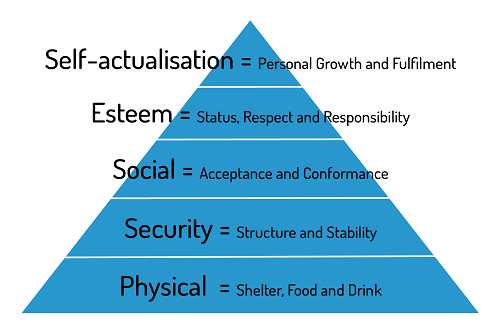The Key to Motivating Staff

What is your key motivation at work? Is it climbing up the ladder? Monetary bonuses? Job satisfaction, to know you are performing well? Is it your colleagues, team or the role itself?
Maslow developed a theory that combines all the main drivers to motivate an employee, he called it the Hierarchy of Needs. Maslow argues that an individual can have many different needs and as a result many motivators which drive them to satisfy each of their needs. These motivators will change with time depending on what position the person is currently in. The theory is used to encourage employers, managers and teachers alike to investigate the individuals in question and discover what their needs and goals are as well as what motivator is driving them to reach it.
Maslow’s Hierarchy of Needs:
At the base of the pyramid are the more basic needs an individual may have. The further up the pyramid the more particular the need and the more satisfied the person is.
Applying the Theory
For example, if a person was struggling to afford food and had a family to look after, they wouldn’t be driving for job satisfaction as that is not their priority. Their priority is to earn as much money they can in order to fulfil their basic needs; food, shelter, clothing etc. If it came to a point where that issue became no longer, the individual and their family are now satisfied. However, with every accomplished goal comes another level of need and with that a new motivator.
This person’s goals now may be to secure their job role and to ensure this, the individual will need to be able to deliver what is expected of them, hit targets and get on well with their team. These are likely to impress their employer which encourages their security within the company. Once that’s satisfied, maybe the individual wants to improve their job satisfaction. Their aim in getting there is through a newly advertised promotion; the role includes more duties they enjoy and are interested in. This is their new motivator which will encourage them to exceed expectations and deliver exceptional results.
People will always have a goal they want to achieve and with that a motivator that will help them get there. I believe this process is always ongoing when one need is satisfied a new one will appear and so on. There will also be de-motivators which likely appear as a result of their efforts, for example, the employee works tremendously hard in order to receive that promotion and in the end, a colleague gets it. This result may demotivate the individual and could alter their goal entirely. They may no longer want to get job satisfaction through promotion as it proved too hard to achieve. This could encourage them to seek a new job elsewhere in order to be satisfied.
Conclusion
In conclusion, know your employees. Understand what their goals and aspirations are. Know that and you’ve unlocked the key to motivating them. Unfortunately, it’s not a one size fits all scenario and I think Maslow’s theory gets that across. Each tier is widespread and covers many needs an individual is likely to have and therefore is quite transferable and easy to apply to yourself.
Employers and Managers: Use this theory to better understand your employees. From the example earlier; an employer could encourage motivation in that individual by offering new opportunities within the company, maybe delegate some duties. This will show the individual that they are working in an environment that aligns with their needs. Whereas, if you had an individual who aspires for job satisfaction, you will need to find out what that pertains to. It could be they want to work in a more creative role or want to improve their sales skills, as an employer, you should present an opportunity for your employees to be able to fulfil that need. This is not to say that you should change their job role entirely or put them on an expensive sales training course; – do what the business can withstand. It’s likely that the opportunity itself will provide the individual with a lot of confidence in the company and with it a lot more motivation and productivity.
Written By Leyla Hussein

